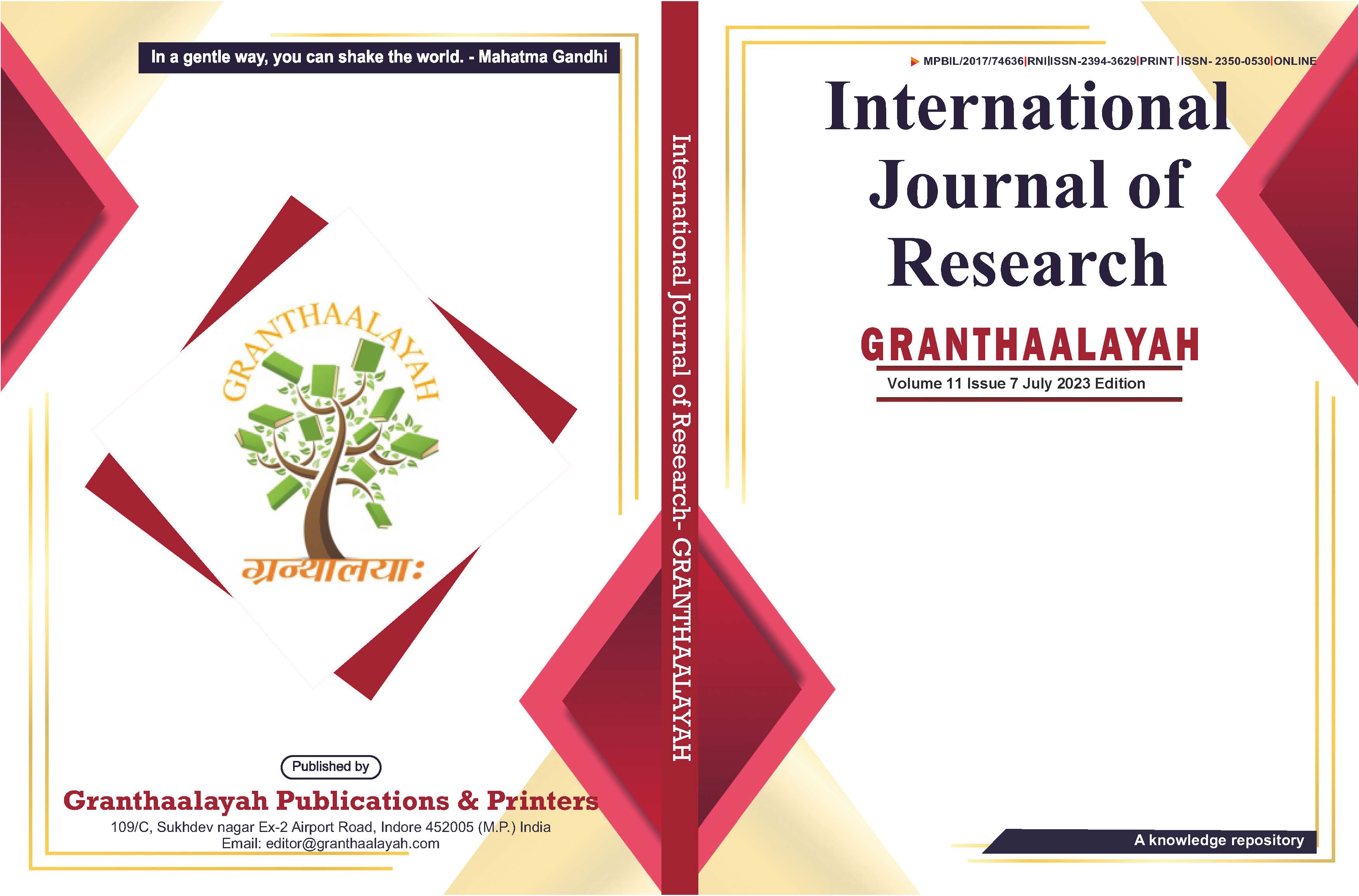A COMBINATION REVIEW ON EFFECT OF CITRUS JUICE AND METRONIDAZOLE IN INFLAMMATORY BOWEL DISEASE
DOI:
https://doi.org/10.29121/granthaalayah.v11.i7.2023.5256Keywords:
Metronidazole, Mesalamine, Citrus Juice, Inflammation, IBD, Ulcerative Colitis, Crohn’sAbstract [English]
The set of inflammatory disorder known’s as inflammatory bowel disease (IBD) affects the gastrointestinal tract and is chronic and complicated condition. Both Crohn's disease and ulcerative colitis, the two main types of inflammatory bowel disease, cause inflammation in the digestive system. Chron's disease can affect any part of the gastrointestinal tract, while ulcerative colitis only affects the colon and rectum. They induce the inflammatory symptoms of swelling, discomfort, an increase in body temperature, redness, and itching. The diagnosis of inflammatory bowel disease requires a careful examination of the patient's medical history, a physical examination, and other tests. Blood tests, imaging scans, and occasionally biopsies. The goal of treatment is to reduce inflammation and symptoms, usually with a combination medication, dietary modification, and occasionally surgical intervention. IBD cannot be cured, however improvements in medical therapy have greatly enhanced patient outcome and care. To effectively manage IBD and improve the quality of life for patients suffering from this difficult condition, regular medical checkup and adherence to treatment plans are essential. The best IBD management and patients well- being depends critically on early detection, prompt intervention and continued support from healthcare provides. Metronidazole and mesalamine drugs are used as different dose in the treatment of IBD inflammation. Some condition citrus juice also used as a treatment because they help in the immune power.
Downloads
References
Boyce, E. G., Cookson, E. T., & Bond, W. S. (1990). Persistent Metronidazole-Induced Peripheral Neuropathy. DICP: The Annals of Pharmacotherapy, 24(1), 19–21. https://doi.org/10.1177/106002809002400103 DOI: https://doi.org/10.1177/106002809002400103
Chand, N., & Sanyal, A. J. (2007). Sepsis-Induced Cholestasis. Hepatology, 45(1), 230–241. https://doi.org/10.1002/hep.21480 DOI: https://doi.org/10.1002/hep.21480
Groothoff, M. V., Hofmeijer, J., Sikma, M. A., & Meulenbelt, J. (2010). Irreversible Encephalopathy After Treatment with High-Dose Intravenous Metronidazole. Clinical Therapeutics, 32(1), 60–64. https://doi.org/10.1016/j.clinthera.2010.01.018 DOI: https://doi.org/10.1016/j.clinthera.2010.01.018
Han, D. S. (2014). Current Status and Prospects of Intestinal Microbiome Studies. Intestinal Research, 12(3), 178–183. https://doi.org/10.5217/ir.2014.12.3.178 DOI: https://doi.org/10.5217/ir.2014.12.3.178
Harper, C. G., Giles, M., & Finlay-Jones, R. (1986). Clinical Signs in the Wernicke–Korsakoff Complex: A Retrospective Analysis of 131 Cases Diagnosed at Necropsy. Journal of Neurology, Neurosurgery, and Psychiatry, 49(4), 341–345. https://doi.org/10.1136/jnnp.49.4.341 DOI: https://doi.org/10.1136/jnnp.49.4.341
Idkaidek, N. M., & Najib, N. M. (2000). Enhancement of Oral Absorption of Metronidazole Suspension in Humans. European Journal of Pharmaceutics and Biopharmaceutics, 50(2), 213–216. https://doi.org/10.1016/S0939-6411(00)00098-9 DOI: https://doi.org/10.1016/S0939-6411(00)00098-9
Kim, D. H., Cheon, J. H., Park, J. J., Yoon, J. Y., Moon, C. M., Hong, S. P., Kim, T. I., & Kim, W. H. (2013). Clinical Outcomes and Predictive Factors for Response After the First Course of Corticosteroid Therapy in Patients with Crohn's, Gut and Liver, 7(1), 58–65. https://doi.org/10.5009/gnl.2013.7.1.58 DOI: https://doi.org/10.5009/gnl.2013.7.1.58
Kim, E., Na, D. G., Kim, E. Y., Kim, J. H., Son, K. R., & Chang, K. H. (2007). MR Imaging of Metronidazole-Induced Encephalopathy: Lesion Distribution and Diffusion-Weighted Imaging Findings. AJNR. American Journal of Neuroradiology, 28(9), https://doi.org/10.3174/ajnr.A0655 DOI: https://doi.org/10.3174/ajnr.A0655
Kim, J. M. (2014). Antimicrobial Proteins in Intestine and Inflammatory Bowel Diseases. Intestinal Research, 12(1), 20–33. https://doi.org/10.5217/ir.2014.12.1.20 DOI: https://doi.org/10.5217/ir.2014.12.1.20
Kuriyama, A., Jackson, J. L., Doi, A., & Kamiya, T. (2011). Metronidazole-Induced Central Nervous System Toxicity: A Systematic Review. Clinical Neuropharmacology, 34(6), 241–247. https://doi.org/10.1097/WNF.0b013e3182334b35 DOI: https://doi.org/10.1097/WNF.0b013e3182334b35
Lamp, K. C., Freeman, C. D., Klutman, N. E., & Lacy, M. K. (1999). Pharmacokinetics and Pharmacodynamics of the Nitroimidazole Antimicrobials. Clinical Pharmacokinetics, 36(5), 353–373. https://doi.org/10.2165/00003088-199936050-00004 DOI: https://doi.org/10.2165/00003088-199936050-00004
Löfmark, S., Edlund, C., & Nord, C. E. (2010). Metronidazole is Still the Drug of Choice for Treatment of Anaerobic Infections. Clinical Infectious Diseases, 50 Suppl. 1, S16–S23. https://doi.org/10.1086/647939 DOI: https://doi.org/10.1086/647939
Manafi A, Panjehshahin MR, Saravi MG, Emami SA, Forootan SK. (2007). Reduced Bioavailability of Oral Metronidazole in Postoperative Ileus. Iran Red Crescent Med J, 129-132.
Manzo, G., De Gennaro, A., Cozzolino, A., Serino, A., Fenza, G., & Manto, A. (2014). MR Imaging Findings in Alcoholic and Nonalcoholic Acute Wernicke’s Encephalopathy: A Review. BioMed Research International, 2014, 503596. https://doi.org/10.1155/2014/503596 DOI: https://doi.org/10.1155/2014/503596
Patel, K., Green-Hopkins, I., Lu, S., & Tunkel, A. R. (2008). Cerebellar Ataxia Following Prolonged Use of Metronidazole: Case Report and Literature Review. International Journal of Infectious Diseases, 12(6), https://doi.org/10.1016/j.ijid.2008.03.006 DOI: https://doi.org/10.1016/j.ijid.2008.03.006
Prantera C, Zannoni F, Scribano ML, et al. (1996). An Antibiotic Regimen for the Treatment of Active Crohn's Disease: A Randomized, Controlled Clinical Trial of Metronidazole Plusciprofloxacin.AmJGastroenterol, 91, 328-332.
Seok, J. I., Yi, H., Song, Y. M., & Lee, W. Y. (2003). Metronidazole-Induced Encephalopathy and Inferior Olivary Hypertrophy: Lesion Analysis with Diffusion-Weighted Imaging and Apparent Diffusion Coefficient Maps. Archives of Neurology, 60(12), 1796–1800. https://doi.org/10.1001/archneur.60.12.1796 DOI: https://doi.org/10.1001/archneur.60.12.1796
Shin, I. S., Seok, H., Eun, Y. H., Lee, Y., Lee, S., Kim, E. R., Chang, D. K., Kim, Y., & Hong, S. N. (2016). Wernicke’s encephalopathy after Total Parenteral Nutrition in patients with Crohn’s disease. Intestinal Research, 14(2), 191–196. https://doi.org/10.5217/ir.2016.14.2.191 DOI: https://doi.org/10.5217/ir.2016.14.2.191
Yamamoto, T., Abe, K., Anjiki, H., Ishii, T., & Kuyama, Y. (2012). Metronidazole-Induced Neurotoxicity Developed in Liver Cirrhosis. Journal of Clinical Medicine Research, 4(4), 295–298. https://doi.org/10.4021/jocmr893w DOI: https://doi.org/10.4021/jocmr893w
Yoon, S. M. (2016). Micronutrient Deficiencies in Inflammatory Bowel Disease: Trivial or Crucial? Intestinal Research, 14(2), 109–110. https://doi.org/10.5217/ir.2016.14.2.109 DOI: https://doi.org/10.5217/ir.2016.14.2.109
Zuccoli, G., & Pipitone, N. (2009). Neuroimaging Findings in Acute Wernicke’s Encephalopathy: Review of the Literature. AJR. American Journal of Roentgenology, 192(2), 501–508. https://doi.org/10.2214/AJR.07.3959 DOI: https://doi.org/10.2214/AJR.07.3959
Zuccoli, G., Pipitone, N., & Santa Cruz, D. (2008). Metronidazole-Induced and Wernicke Encephalopathy: Two Different Entities Sharing the Same Metabolic Pathway? AJNR. American Journal of Neuroradiology, 29(9), E84; Author Reply E85. https://doi.org/10.3174/ajnr.A1142 DOI: https://doi.org/10.3174/ajnr.A1142
Published
How to Cite
Issue
Section
License
Copyright (c) 2023 Deeksha, Shalini Saini, Meenakshi Bhatt

This work is licensed under a Creative Commons Attribution 4.0 International License.
With the licence CC-BY, authors retain the copyright, allowing anyone to download, reuse, re-print, modify, distribute, and/or copy their contribution. The work must be properly attributed to its author.
It is not necessary to ask for further permission from the author or journal board.
This journal provides immediate open access to its content on the principle that making research freely available to the public supports a greater global exchange of knowledge.

























